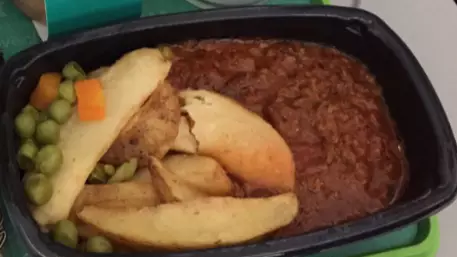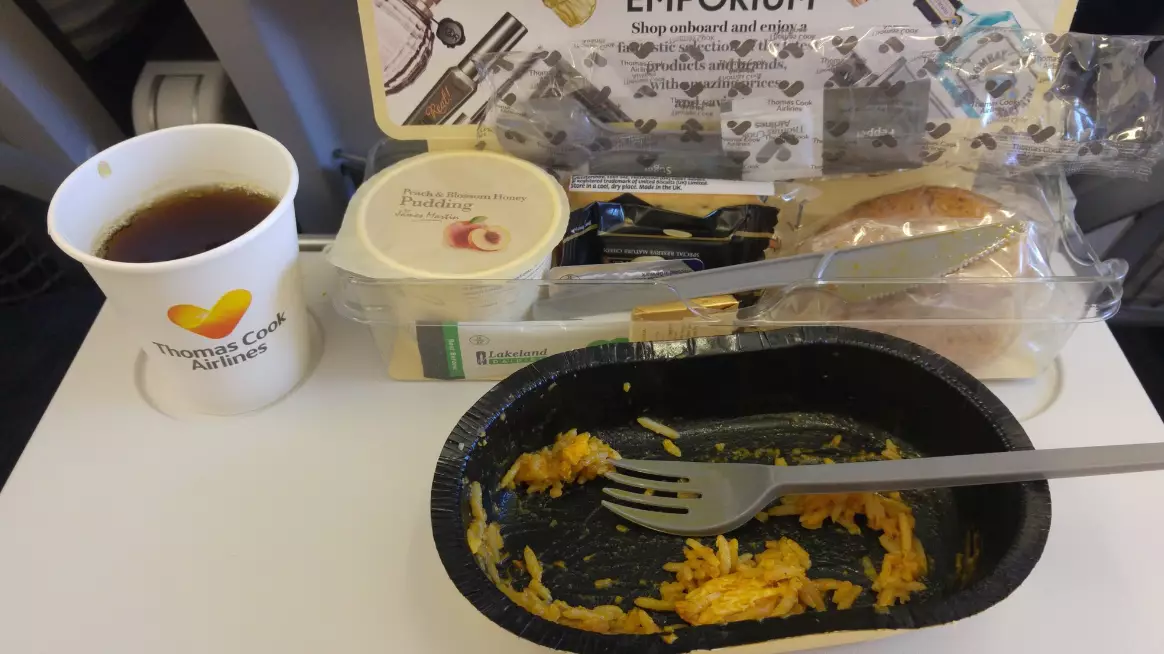
On a short-haul flight you can get away with avoiding it, for the long-hauler it's a little more tricky.
From the barely edible, to something that looks like you've just brought up last night's kebab. Yes - it's aeroplane food.
Not many travellers are a fan of the microwaved meals, often labelled 'fresh', and here we take a look at what makes them so bad.
Below is all the information you need to know about each stage of your in-flight meal.
Advert
It is advisable to have the bin within reaching distance.
Ready Meals
It doesn't matter what class you are in, the food all comes from the same place: an industrial kitchen near the airport. From here it's cooked pre-take-off and then reheated on board.
These kitchens, most common in Switzerland or Germany, make around 25,000 meals per day, and together the combined industry is worth £10bn per year.

Credit: Twitter
Advert
Fresh Doesn't Mean Fresh
In fact, it could be between 12 and 72 hours old. Professor Peter Jones, formerly of Surrey University, said that certain food 'can be kept in a chilled stage for five days under the internationally recognised food hygiene standards'.
Salads, desserts, bread rolls, plastic cutlery and napkins are put on trays in catering units on the grounds and then stacked in trolleys ready to be wheeled down the aisle.
For the hot dishes, they shift from large industrial pans to plastic containers with foil lids before being 'blast chilled' to around 5 degrees in 90 minutes.
Plastic Fantastic
While some people in first class like to think they are better than everyone else with their 'freshly prepared' meals, in reality they are still put together on the ground.
Staff are given 'step-by-step' instructions on exactly how to plate up the dishes, posh-style, and guests are even given metal cutlery to add to the effect.
Professor Charles Spence, of Oxford University, says plastic cutlery, for cattle-class, can affect the taste through 'sensation transference'. "We've shown that if you have heavy cutlery you rate food better and will pay more," he said. "Plastic takes you down by ten per cent."
Credit: Harry Enfield / BBC
Advert
Pass On Pasta
Here's a handy tip to make sure you food isn't dried out: go for the option with the most sauce. Almost as if 'wetter is better' - a phrase first used by French chef, Raymond Oliver, in 1973.
Professor Spence added: "You often have dishes with tomato, parmesan or mushrooms; this allows you to make food tastier without adding too much salt."
On the other hand, pasta, rice or noodle dishes just don't hold themselves when re-heated. Fried food is very similar.
Bring Your Own
Apart from bringing your own food, it is advised you bring additional salt and pepper.
Professor of the Centre For The Study of Senses, Barry Smith, at the University Of London said: "The environment of an aircraft is about the most hostile to having a good dining experience that you could imagine."
Humidity is often less than 12 per cent (lower than most deserts), which can make tasting any food difficult whilst at 30,000ft. So, no matter how well flavoured that meal is on the ground, up in the air, it can be practically tasteless.
I Could Murder A Brew
A common phrase at any height. But the higher up in the air you go, the lower the boiling point (it's just 90 degrees when in a low pressure-controlled cabin). It means a poor-quality cuppa, or a different tasting coffee. The quality of on-board water is also sub-standard.
Some have tried to correct this, Singapore Airlines created a special plane coffee with more flavoursome beans, whilst Twinings designed the 'high tea' which is intended to make a cracking brew even when at a lower temperature.
Posh Nosh
There has been some improvement in quality with the introduction of celebrity chefs to a few airlines. Lorraine Pascale has provided meals for Virgin Atlantic, while Heston's got British Airways covered.
While this has seen an upping of standards, every ingredient is measured to the hundredth of a gram to help with weight restrictions.
In the eighties, it was said American Airlines could save £31,000 per year by removing a single olive from each passenger's salad.

Credit: Twitter
Advert
Whine And Dine
Yep, the noise of the aircraft engine can also affect the quality of your in-flight meal.
Professor Spence said: "Background noise suppresses the ability to taste sweet and salty, but enhances the ability to taste unami, the meaty, savoury taste you find in food such as tomatoes."
His recommendation is to use headphones with sound-cancelling functions when you eat while high in the sky.
Advert
Even your alcohol can taste different when flying. Subtle fruit flavours are diminished and drinkers are left with bitter tastes.
This is because the liquid thins out and becomes 'leaner' in the air, in response to changing atmospheric pressure. As a result, most airlines serve younger, fruitier red wine over white.
Champagne, according to Professor Smith, is a bigger winner though.
He said "It has a flavour delivery system of its own. The bubbles rise in the mouth and nose and are coated with liquid so they deliver the odour and flavour."

Credit: Twitter
Feeling Full
That meal, as small as it may be, can make you feel fuller because your body swells at low pressures. Your intestines struggle to digest food as fast, hence that bloated feeling.
The foods tend to be high in fat, salt and sugar, with 360-400 calories per food item. Professor Jones added: "Airlines are not hugely concerned about nutrition because their view is that one meal consumed by a passenger will not make the slightest bit of difference to them out the thousands of meal they consume."
Featured Image Credit: Twitter